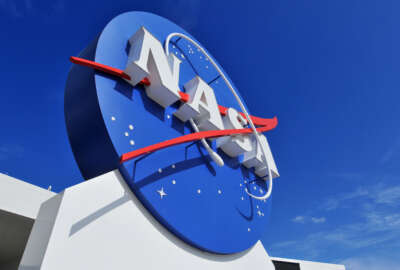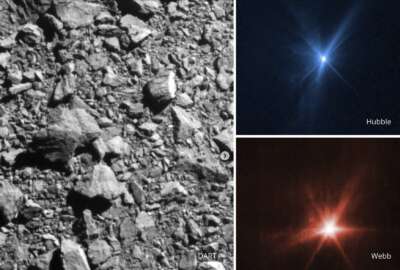Sponsored by Four Inc. and IBM
At NASA, ‘data fuels everything we do’ – like a return to the moon
Chief Data Officer David Salvagnini says NASA's Artemis mission depends on its wealth of scientific data — including data from the Apollo missions more than a...
NASA’s Artemis mission will bring U.S. astronauts back to the moon’s surface more than 50 years after its last trip, the 1972 Apollo 17 mission. The agency expects a crewed moon landing mission will occur in 2025.
NASA Chief Data Officer David Salvagnini said the Artemis mission depends on the agency’s wealth of scientific data — including data from the Apollo missions more than a half-century ago.
“Data fuels everything we do. Data fuels scientific research. It fuels all of our open science initiative work … It fuels all of our missions, from a risk mitigation perspective, and from a program development perspective,” Salvagnini said in an interview. “So we are a very data-centric organization by default.”
To prepare for this historic mission, NASA is pursuing advanced communications technology for space-based system technologies that will allow it to move more data more rapidly.
Salvagnini said these technologies will increase bandwidth by “orders of magnitude,” which the agency will need, as improved sensor technology leads to higher-resolution images and larger data files.
“NASA is always looking at ways to further its exploration by being able to harness some of the data that becomes available to us through these various sophisticated sensors that are deployed, not only in space, but also on Earth,” he said.
NASA, as part of this mission, will establish an Artemis Base Camp on the surface of the moon, and a “Gateway” spaceship that will remain in lunar orbit for more than a decade.
“With a persistent presence on the moon, and with a station in orbit around the moon, there’ll be a lot of data there as well,” Salvagnini said. “Those platforms become a way in which we can relay information in an efficient manner, from deep space-based sensors back to Earth for analysis.”
Salvagnini, who joined NASA in June, said one of his key priorities is improved data sharing across the organization.
“Part of sharing is really discovery. So if an officer at NASA is looking to do work, they’ve got to be able to discover data before they can even expect it to be shared with them,” he said.
Part of this work started when the White House Office of Science and Technology set 2023 up as the “Year of Open Science,” an interagency effort to make federal data and research more available to the public.
Salvagnini said NASA, under the Year of Open Science effort, is focused on creating a “share-first” culture around data —as opposed to limiting access by default. That effort includes breaking down some of the barriers to access that may fall along organizational or mission lines.
“I think there’s a human tendency by some to see the value of the data that they have, and for a number of reasons, not necessarily think to make it available to all and or share that data more widely,” he said.
Salvagnini said NASA, as part of this effort, is working with “citizen scientists” to contribute to some of its work.
“NASA realized that we’ve got amazing intellectual capacity within this organization. But our ability to solve problems internally is quite advanced. But it’s even better if we share some of the problems that we have more broadly. And we solicit the thoughts from external contributors,” he said.
Some of the concerns around sharing data more widely include the risk of data being misused and misinterpreted outside the program office or project that’s managing the data.
“This one, in particular, is a challenge with some of the very sophisticated datasets that we hold where, unless you’re a specialist in a particular field, you may not be able to interpret the data in a way that’s accurate. As such, you could arrive at a faulty conclusion,” Salvagnini said.
Salvagnini said he’s looking at creating a “top-tier search capability” that would give NASA employees the ability to search for data across multiple systems.
“So basically, [it’s] a single point of entry for a search that is able to cast a broad net across all the holdings at NASA, and tap all those indexes of information that we have, and bring results back,” he said.
Salvagnini said NASA is also in talks with hyperscale computing vendors to ensure the agency has the cloud infrastructure necessary to support its data.
“We are a very data-centric organization by default. Now, that’s not to say that there aren’t opportunities for us to mature. And that’s exactly where I’m focused on — looking at those opportunities, and then figuring out okay, ‘How do we advance the ball for NASA?’” he said.
Salvagnini joined NASA in June 2023, but has held several roles in the federal government since 2005. Among those positions, he previously served as CDO at the Defense Intelligence Agency.
“As you can imagine, the mission at NASA is quite different than the mission in the intelligence community. Also, the public-facing role of NASA is quite different than what I’m used to in the intelligence community. And quite candidly, I have thoroughly enjoyed the switch,” Salvagnini said.
Salvagnini isn’t alone in keeping NASA’s data modernized to keep pace with its mission. NASA also has its Data Stewardship Community of Practice, which predates his tenure at the agency.
“More momentum is growing around that group, but that’s organic. That is people seeing a need, seeing a gap and working together to solve a problem,” he said.
NASA’s Science Mission Directorate in April 2021 also named Kevin Murphy as its first chief science officer.
“There’s organizations that are standing up data governance. They’re doing it not because I said they have to stand up data governance. They’re doing it because they see value in doing so. They’re seeing that they have to govern their data, because they do see their data as an asset, and they see the value that it holds,” Salvagnini said.
Salvagnini said “undeclared data heroes across NASA” are also helping NASA to advance its data mission.
“That’s those people who have a data role. And they don’t necessarily identify with that data role. But they are doing all the work that a CDO or data steward or any number of other data practitioners might do, just because they know that it has to be done,” he said. “They see the need, and they’re rolling up their sleeves, and they’re taking care of things for that particular organization.”
Copyright © 2025 Federal News Network. All rights reserved. This website is not intended for users located within the European Economic Area.
Jory Heckman is a reporter at Federal News Network covering U.S. Postal Service, IRS, big data and technology issues.
Follow @jheckmanWFED






